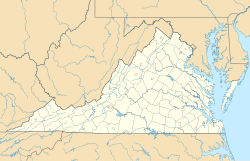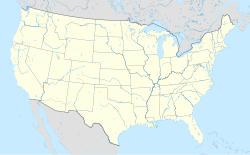Shenandoah University is a private university in Winchester, Virginia, United States. It has an enrollment of approximately 4,000 students across more than 200 areas of study in six schools and colleges. Shenandoah University is one of five United Methodist Church-affiliated institutions of higher education in the Commonwealth of Virginia.[3]
 Presidential Seal | |
Former names | Shenandoah Seminary (1875–1925) |Shenandoah College and Conservatory of Music (1925–1991) Shenandoah Conservatory (separate institution 1937–1974) |
|---|---|
| Motto | The Big Little University Rising |
| Type | Private |
| Established | 1875 |
Religious affiliation | United Methodist Church |
| Endowment | $85 million (2024)[1] |
| President | Tracy Fitzsimmons |
| Students | 4,343 students (fall 2023) [2] |
| Undergraduates | 2,590 (fall 2023)[2] |
| Postgraduates | 1,753 (fall 2023) [2] |
| 243 doctoral degrees conferred in 2022-2023 academic year [2] | |
| Location | , Virginia , United States 39°09′58″N 78°09′29″W / 39.166°N 78.158°W |
| Campus | Small city |
| Colors | Red and blue |
| Nickname | Hornets |
Sporting affiliations | NCAA Division III |
| Website | su |
History
editFounding and early history
editAbram Paul Funkhouser and John (Jay) Paul Fries founded the school as Shenandoah Seminary on February 12, 1875.[4] At the time, it was located on a 10-acre (4.0 ha) campus in Dayton, Virginia, and classes were initially held in a two-room log cabin.[5][6] The school had 11 students enrolled in its first year.[6] Over the next 85 years, the institution changed names six times but always kept “Shenandoah” as part of its name.[7]
Shenandoah Seminary became a junior college in 1924, changing its name to Shenandoah College the following year. Shenandoah Conservatory became a separate corporation in 1937 and began granting four-year degrees.
Move to Winchester
editIntense competition from neighboring colleges and universities, along with increasing long-term operating deficits, created low morale. The college urgently required a solution to prevent its closure. On June 2, 1952, President L. P. Hill resigned, effective immediately. Eight days later Reverend Troy Brady[7] was elected as president by the Evangelical United Brethren (EUB)[8]
President Brady implemented various strategies such as student recruitment, expanding course options, fundraising, and slashing unnecessary expenses. Despite these efforts, the enrollment continued to decline and the possibility of closure was imminent.[9]
In a desperate move, Troy reached out to Washington and arranged a meeting with Democratic Senator Harry F. Byrd at his office in Washington, D.C. Byrd recommended that Troy contact his son in Winchester, who ran The Winchester Star Newspaper.[9]
Troy was then directed to the Winchester Chamber of Commerce, where he met with committee president and prominent local business leader, James R. Wilkins, Sr. James assisted Troy in the endeavor of relocating the school to Winchester. He regularly participated in board meetings with Brady to engage with EUB members. Through Wilkins' efforts he secured a plot of land from Winchester's Jim Barnett Park for the college, where the main campus is currently located.
On June 28, 1956, the EUB approved the school's move to Winchester. Two days later, Brady resigned, and Dr. Forrest Racey, Class of 1923, took over as president. Continuing Brady's work with the City of Winchester.
Shenandoah May 17th, 1959[8] Shenandoah College auctioned off its Dayton campus for $107,875[10] and construction began on the new campus on February 6th, 1958—opening in Winchester in September 1960,[6] with two academic buildings, Gregory and Armstrong Halls.[8]
The 360-acre Winchester campus[11] and began offering four-year degrees in 1974 (at which time the college and conservatory corporations were merged).
Shenandoah obtained university status on January 1, 1991. The university, as of fall 2023, had 265 full-time and 189 part-time faculty members. The student body represented 42 foreign countries as well as 48 states plus the District of Columbia, Puerto Rico, and Guam. Over 70 percent of full-time faculty had a doctorate in their fields or other terminal degree.
Name
editAccording to the university's official history, the name Shenandoah is derived from the Native American legend of Zynodoa, a brave warrior whose life of strength and courage and his appreciation of beauty resulted in having a river and a valley named for him. Popular myth further ascribes translation of the word "Shenandoah" to mean "daughter of the stars".[12]
Locations
editThe university operates in five locations:
- Winchester
- Loudoun
- Downtown Winchester
- Health Professions Building on the campus of Winchester Medical Center
- Shenandoah River Campus at Cool Spring Battlefield
The main location of campus is in Winchester near Interstate 81, and the Health Professions Building is located near the Winchester Medical Center. The Loudoun site in Ashburn, Virginia, is home to graduate programs in business, education, leadership studies, occupational therapy, physical therapy, and physician assistant studies, as well as the accelerated-second-degree Bachelor of Science in Nursing program. There are also satellite offices and facilities located throughout Winchester.
In 2013, Shenandoah University accepted stewardship of 195 acres of land along the Shenandoah River, now known as the Shenandoah River Campus at Cool Spring Battlefield. Purchased by the Civil War Trust in 2012, stewardship of the property transferred to the university in spring 2013 to protect and preserve the former battlefield site. The property now serves as an outdoor classroom and living laboratory for the university community and the general public.
Academics
editShenandoah offers more than 200 areas of study at the bachelor's, master's, and doctoral-degree levels, as well as through undergraduate and graduate certificates, across six schools. Its programming includes Virginia's first bachelor's degrees in virtual reality design and esports management, as well as the state's oldest music therapy program (offered at the undergraduate and graduate levels).
- College of Arts & Sciences
- School of Business
- Shenandoah Conservatory
- Bernard J. Dunn School of Pharmacy
- Eleanor Wade Custer School of Nursing
- School of Health Professions
Shenandoah University no longer offers a tenure track for new faculty members. Instead, new faculty members undergo a 5-year probationary period, after which they are eligible for 3-year, renewable "career faculty contracts".[13]
Athletics
editThe Shenandoah athletic teams are called the Hornets. The university is a member of the NCAA Division III ranks, primarily competing in the Old Dominion Athletic Conference (ODAC) since the 2012–13 academic year. The Hornets previously competed in the USA South Athletic Conference (USA South) from 1992–93 to 2011–12.
Shenandoah competes in 22 intercollegiate varsity sports: Men's sports include baseball, basketball, cross country, football, golf, lacrosse, soccer, tennis, track & field (indoor and outdoor) and wrestling; while women's sports include basketball, cross country, field hockey, golf, lacrosse, soccer, softball, tennis, track & field (indoor and outdoor) and volleyball.
The university announced the creation of a Marching Band in June 2021, which debuted during the fall 2022 semester.[14]
In fall 2023, football safety Haley Van Voorhis became one of the first women to play a position other than kicker in an NCAA football game, at any level.
Notable alumni
edit- Carter Beauford, American drummer, percussionist, and founding member of Dave Matthews Band
- Stanley Draper, an influential community leader responsible for the development of Oklahoma City[15]
- Kate Flannery, actress, played Meredith Palmer (2005–2013) in the television comedy The Office[16]
- Wendy Gooditis, an American real estate agent, educator, and Democratic politician.
- Tiffany Lawrence, a former Democratic member of the West Virginia House of Delegates, representing the 65th district.
- Harold Perrineau, actor, played Link in The Matrix Reloaded and The Matrix Revolutions
- Carl Tanner, an American operatic tenor
- Haley Van Voorhis, current safety for Hornets football and the first woman to play a non-kicking position in NCAA football
- Mac Wiseman, Bluegrass music legend
- Richard Zarou, a contemporary composer of concert and film music and the host of the new music podcast No Extra Notes
References
edit- ^ As of January 1, 2024. Wilkins, James R., et al. “My Family and Shenandoah University.” Man on the Move: A Memoir, by James R. Wilkins Jr, James R. Wilkins Jr, Winchester, VA, 2022, p. 160, Accessed 2024.
- ^ a b c d "Quick Statistics". Shenandoah University.
- ^ "About Us – Shenandoah University". Retrieved March 21, 2018.
- ^ Walker, James A. “VA Senate Bill 107.” Richmond: Virginia, April 2, 1879.
- ^ "Shenandoah College Will Sell Old Campus". Associated Press. The Times Dispatch (Richmond, Virginia). May 15, 1960. p. 2D.
- ^ a b c "A College Moves 70 Miles". The Daily News Leader (Staunton, Virginia). November 17, 1960. p. 4.
- ^ a b "History". Shenandoah University. Retrieved September 10, 2024.
- ^ a b c Wilkins, James Richard. “Chapter 3 - Shenandoah’s Problem Years - 1921-1954.” The Impossible Task: A History of Shenandoah University, 1875 to 1995. Winchester, Va., VA: J.R. Wilkins, 1995.
- ^ a b Brady, Robert M. “Elkins and Shenandoah College.” Essay. In Pop Troy’s Anthology 2, 2:40–44, 1992. https://sites.rootsweb.com/~bradytrilogy/anthology/elkins-shenandoah.html.
- ^ "College Campus, Buildings Sold for $107,875". Associated Press. The Bee (Danville, Virginia). p. 1-D.
- ^ "SU Quick Statistics". September 17, 2024.
- ^ Julia Davis, "The Shenandoah", Rivers of America, New York: Farrar & Rinehart, Inc., 1945, pp. 20–21
- ^ "Section 4: Contractual Statement". Retrieved August 6, 2023.
- ^ "Marching Band". Shenandoah University. Retrieved August 3, 2022.
- ^ "Draper, Stanley Carlisle | The Encyclopedia of Oklahoma History and Culture". Oklahoma Historical Society | OHS. Retrieved December 27, 2023.
- ^ "One on One with Kate Flannery – HoboTrashcan". www.hobotrashcan.com. Retrieved August 6, 2023.


